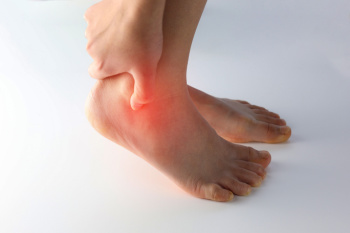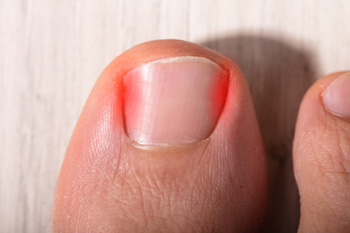

Ankle pain while running is an issue that many runners face. It can be caused by several factors, ranging from overuse to wearing improper footwear. Overuse, where repetitive impact from running leads to stress on the ankle joints and surrounding muscles, causes inflammation. Poor running form can put excessive strain on the ankles and lead to discomfort. Running on uneven surfaces or wearing shoes that do not provide adequate support can also contribute to ankle pain. In some cases, underlying conditions such as tendinitis, sprains, or stress fractures may be the source of pain. It is essential to listen to the body and take breaks when needed. Proper warm-ups, strength training, and wearing well-fitting shoes can help reduce the risk of ankle pain and improve overall running performance. If you enjoy running and are experiencing ankle pain, it is suggested that you consult a podiatrist who can offer you effective relief in addition to tips on preventing ankle pain.
Ankle pain can be caused by a number of problems and may be potentially serious. If you have ankle pain, consult with Dr. Stephan J. LaPointe from Georgia Foot & Ankle Specialists . Our doctor will assess your condition and provide you with quality foot and ankle treatment.
Ankle pain is any condition that causes pain in the ankle. Due to the fact that the ankle consists of tendons, muscles, bones, and ligaments, ankle pain can come from a number of different conditions.
Causes
The most common causes of ankle pain include:
Symptoms
Symptoms of ankle injury vary based upon the condition. Pain may include general pain and discomfort, swelling, aching, redness, bruising, burning or stabbing sensations, and/or loss of sensation.
Diagnosis
Due to the wide variety of potential causes of ankle pain, podiatrists will utilize a number of different methods to properly diagnose ankle pain. This can include asking for personal and family medical histories and of any recent injuries. Further diagnosis may include sensation tests, a physical examination, and potentially x-rays or other imaging tests.
Treatment
Just as the range of causes varies widely, so do treatments. Some more common treatments are rest, ice packs, keeping pressure off the foot, orthotics and braces, medication for inflammation and pain, and surgery.
If you have any questions, please feel free to contact our office located in Rome, GA . We offer the newest diagnostic and treatment technologies for all your foot care needs.

Corns and calluses are thickened areas of skin that develop due to repeated friction or pressure, often on the feet. Corns typically form on the toes, while calluses appear on the soles. Common causes include ill-fitting shoes, high-impact activities, and foot deformities. Symptoms include localized pain, discomfort, and thick, hardened skin. While these conditions are not usually serious, they can lead to further foot problems if left untreated. Treatment options include regular exfoliation, moisturizing, and using protective pads. In more persistent cases, a podiatrist can provide professional care, such as safely removing corns and calluses and addressing any underlying issues. If you are struggling with corns or calluses, it is suggested that you make an appointment with a podiatrist. This foot doctor can develop a personalized treatment plan to relieve your discomfort and help you maintain healthy feet.
If you have any concerns regarding your feet and ankles, contact Dr. Stephan J. LaPointe of Georgia Foot & Ankle Specialists . Our doctor will treat your foot and ankle needs.
Corns: What Are They? and How Do You Get Rid of Them?
Corns can be described as areas of the skin that have thickened to the point of becoming painful or irritating. They are often layers and layers of the skin that have become dry and rough, and are normally smaller than calluses.
Ways to Prevent Corns
There are many ways to get rid of painful corns such as wearing:
Treating Corns
Treatment of corns involves removing the dead skin that has built up in the specific area of the foot. Consult with Our doctor to determine the best treatment option for your case of corns.
If you have any questions please feel free to contact our office located in Rome, GA . We offer the newest diagnostic and treatment technologies for all your foot and ankle needs.

Ingrown toenails occur when the nail grows into the surrounding skin causing pain, swelling, and sometimes infection. Common causes include improper nail trimming by cutting nails too short or rounding the edges, leading the nail to grow into the skin. Wearing tight or narrow shoes can also push the nail into the skin, increasing the risk. Other common causes include trauma, such as stubbing or injuring the toe, and repetitive pressure from activities like running. Less common causes include genetic predisposition, where nail shape naturally curves into the skin, and nail disorders or fungal infections that alter nail growth. A podiatrist diagnoses ingrown toenails by examining the affected toe for signs of redness, swelling, and infection. Treatment varies by severity, with mild cases usually requiring trimming and proper nail care guidance. More severe cases may need partial nail removal, antibiotics for infection, and sometimes a minor surgical procedure to prevent recurrence. If you have an ingrown toenail, it is strongly suggested that you visit a podiatrist for proper treatment.
Ingrown toenails may initially present themselves as a minor discomfort, but they may progress into an infection in the skin without proper treatment. For more information about ingrown toenails, contact Dr. Stephan J. LaPointe of Georgia Foot & Ankle Specialists . Our doctor can provide the care you need to keep you pain-free and on your feet.
Ingrown Toenails
Ingrown toenails are caused when the corner or side of a toenail grows into the soft flesh surrounding it. They often result in redness, swelling, pain, and in some cases, infection. This condition typically affects the big toe and may recur if it is not treated properly.
Causes
You are more likely to develop an ingrown toenail if you are obese, have diabetes, arthritis, or have any fungal infection in your nails. Additionally, people who have foot or toe deformities are at a higher risk of developing an ingrown toenail.
Symptoms
Some symptoms of ingrown toenails are redness, swelling, and pain. In rare cases, there may be a yellowish drainage coming from the nail.
Treatment
Ignoring an ingrown toenail can have serious complications. Infections of the nail border can progress to a deeper soft-tissue infection, which can then turn into a bone infection. You should always speak with your podiatrist if you suspect you have an ingrown toenail, especially if you have diabetes or poor circulation.
If you have any questions, please feel free to contact our office located in Rome, GA . We offer the newest diagnostic and treatment technologies for all your foot care needs.

A sprained ankle occurs when the ligaments that support the ankle are stretched or torn, often due to sudden twists, falls, or awkward landings. This common injury can happen during sports, physical activities, or even everyday movements. Symptoms typically include swelling, bruising, pain, and difficulty bearing weight on the affected foot. Initial treatment often includes rest and elevation, which can help reduce swelling and pain. However, if you experience severe pain, significant swelling, or have difficulty walking, it is important to seek medical attention. A podiatrist may recommend imaging tests to assess the severity of the sprain and could suggest a walking boot, targeted exercises, or even surgery, in more severe cases. If you are experiencing persistent symptoms or difficulty moving your ankle, it is suggested you schedule an appointment with a podiatrist for a thorough evaluation and tailored treatment options.
Although ankle sprains are common, they aren’t always minor injuries. If you need your ankle injury looked at, contact Dr. Stephan J. LaPointe from Georgia Foot & Ankle Specialists . Our doctor can provide the care you need to keep you pain-free and on your feet.
How Does an Ankle Sprain Occur?
Ankle sprains are the result of a tear in the ligaments within the ankle. These injuries may happen when you make a rapid shifting movement while your foot is planted. A less common way to sprain your ankle is when your ankle rolls inward while your foot turns outward.
What Are the Symptoms?
Preventing a Sprain
Treatment of a Sprain
In many cases, the RICE method (Rest, Ice, Compression, and Elevate) is used to treat ankle sprains. However, you should see a podiatrist to see which treatment option would work best with your injury. In severe cases, surgery may be required.
It is important to ask your doctor about rehab options after you receive treatment for your injury. Stretching, strength training, and balance exercises may help the ankle heal while also preventing further injury.
If you have any questions, please feel free to contact our office located in Rome, GA . We offer the newest diagnostic and treatment technologies for all your foot care needs.